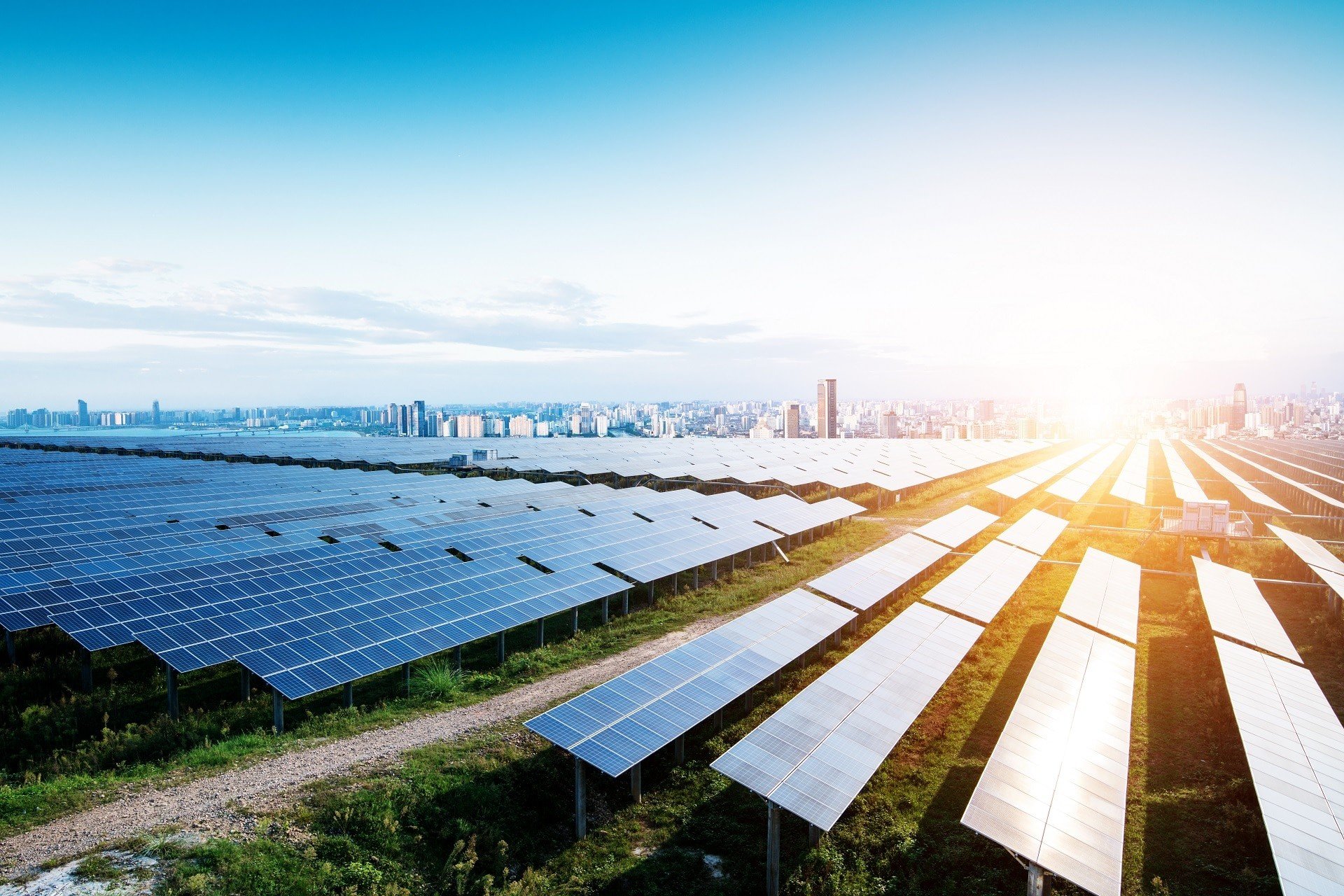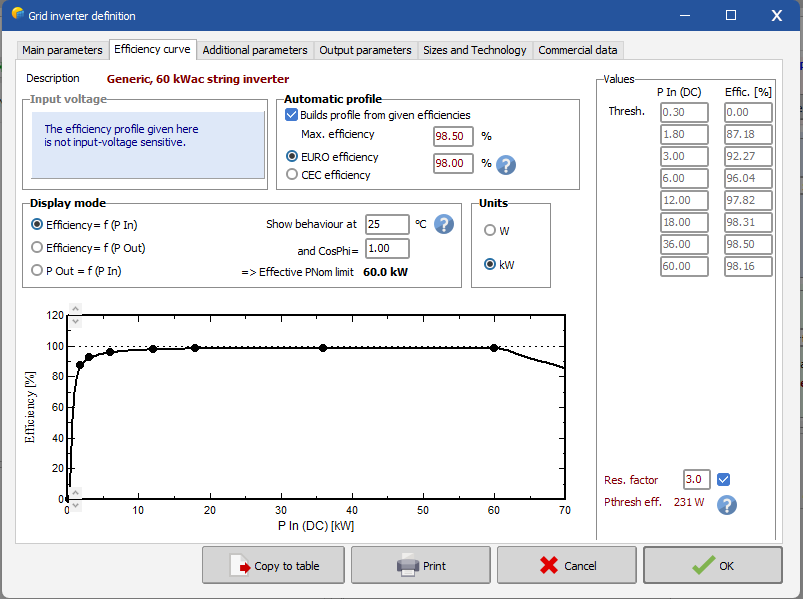-
Posts
793 -
Joined
-
Last visited
Everything posted by Michele Oliosi
-
Okay, if the power-sharing is defined, the second possible reason is that some sub-arrays do not satisfy the following: The number of strings should be a multiple of the number of MPPTs, for each sub-array. This is easy to fix: for example, instead of defining a single sub-array with 5 MPPT and 6 strings, define one sub-array with 1 MPPT and 2 strings, and another with 4 MPPT and 4 strings. A warning message about this is supposed to show up, but other warnings sometimes mask it.
-
If all the MPPT have strings on the same orientation, then it is possible to use the power-sharing to equalize the nominal DC:AC ratios. This allows covering the case of strings of different sizes / different strings on different MPPTs of the same inverter. For the latter case, you should therefore use the multi-MPPT feature, with power-sharing properly set up. If the losses are much higher in the situation 2), it probably means that the power-sharing was not defined yet. Case 1) can be considered an approximation, since then you have to define only one type of string. The problem with the power-sharing happens when you have different orientations AND different DC:AC ratios among the MPPTs. This case cannot be defined properly in PVsyst with the power-sharing.
-
@Matcor Duarte this is a different issue. The original post had two different weather data sources. In your case, changing the configuration probably also changed the tracking or orientation in some way? This would explain some differences in the GlobInc variable. Take a look and compare the “general parameters” frame in the report.
-

How is near shading irradience losses caclulated?
Michele Oliosi replied to Lima's topic in Shadings and tracking
near shadings : irradiance loss electrical shadings : electrical mismatch loss caused by partial shadings -

How is near shading irradience losses caclulated?
Michele Oliosi replied to Lima's topic in Shadings and tracking
The minimum height above ground is not very relevant to the near shadings. If your trackers go to 60° rotation angles: - it means they will follow the sun much lower than the 13° ones, inducing more mutual shadings if backtracking is not active - the diffuse component is also subject to more mutual shadings -

Batch simulation - Not getting .csv 8760 for each SIM
Michele Oliosi replied to JStief's topic in Problems / Bugs
-

Large batch simulation of tracker based systems
Michele Oliosi replied to Matt's topic in Simulations
Hi Matt, I see. In fact, the importance of shadings depends on your choice of tracking algorithm. If you use traditional true tracking, then indeed shades may be important. However, many tracking systems use backtracking, which, for low sun angles, sets the trackers at more horizontal angles, to avoid shading the direct irradiance component. When using the batch to change the pitch and number of trackers on your "array of trackers" (that is defined as an array in the 3D scene), make sure that you also change the number of modules, strings, and inverters accordingly (and if applicable). -

Large batch simulation of tracker based systems
Michele Oliosi replied to Matt's topic in Simulations
Hi, indeed, this is a difficult task, and I am not sure how much can be done with the tools in PVsyst's 3D scene. I assume that tracker shading issues are due to the topography. The issue is mostly that the changes you want to make are at risk of being under-determined. You mention varying the module quantity and pitch, but then how do you decide the table arrangement ? Surely it will follow some rules. I can imagine that the rule would be to fill a predetermined zone as much as possible. To do this for a single simulation, I would generally employ the zone tool in PVsyst. However, there is no interaction between zones and the batch mode at the moment, so it is not useful to run a batch. In other words, this is no good in your case. The tracker shading issues is a small effect, and it will have very small differences from variant to variant. I think these differences will be well within the uncertainty of the 3D modeling to begin with. So I would suggest the following simplification: run one variant with topography and a detailed layout of trackers on it. This will give you a reference in terms of shading losses and especially electrical shading losses (which are not present on flat ground when backtracking) run your batch on a simplified array of trackers on flat ground. If you use a single Array of trackers, you can then more easily use the batch to change geometric variables or the number of modules and so on. Add the extra losses from the topography variant to the simplified variants as another loss, e.g., string mismatch. Of course, this is a crude approximation, but probably within the uncertainty of the system modeling. TLDR: this is a collection of thoughts on how to approach the problem, not sure how much it will help. -
Let us know if I didn't understand the ramp-up part correctly. I am not sure if you are writing about a simple grid curtailment or something more complex.
-
If I understand correctly, when this event happens, there is a more restrictive grid-injection limitation or grid curtailment. There is no functionality to cover that in a single simulation, at the moment. However, you could run two simulations, one with the normal, and the other with the more restrictive grid curtailment limit. If you export the hourly CSV files (https://www.pvsyst.com/help/output_file.htm), you can then use a data analysis or spreadsheet tool to combine the data when you wish during the year.
-

Batch simulation - Not getting .csv 8760 for each SIM
Michele Oliosi replied to JStief's topic in Problems / Bugs
You are right, trackers are difficult to change into fixed tilt. Have you tried the other way around ? If I recall correctly, there is a transform option to change fixed tilt into trackers. In this way, you can only build the scene with fixed tilt and then transform it. Regarding the tilt angles, you are right, it can only go from 0° to 90° in principle. I would advise creating your scene with fixed tilt, and then rotate all tables by 180°. This should ensure that you cover the originally negative tilts. The operation of rotating all tables by 180° may be a bit technical depending on the case. I would suggest you try, and then refer to us which specific issues you encounter. -
There is also this FAQ post:
-
Hi ! Sorry for the delay as this is a difficult question. As you point out, there is a complex hierarchy of uncertainties, some of which are well-defined, others less so. Just zooming out at first, we tend to classify the relevant uncertainties according to the use that you intend to do. As one goes down in the hierarchy, the order of magnitude of the uncertainties decreases, in general. It is an okay approximation to assume that the uncertainties are compounded with an RMS sum. The first level would be in the case of yield estimates or PXX evaluations. In this case, the dominant factor is: The year-to-year weather variability (O(5%)) The second level is in the case of comparisons with actual data, when you use measurements, or historical data as input. Here the order of magnitude can vary widely, both for the measurement uncertainty, or the parametrization (e.g., given the experience of the modeler). However, certain studies, e.g., the PVPMC blind modeling, show that this uncertainty can be higher than expected ! All in all, I would summarize these uncertainties as (O(1%)). Measurement uncertainty Parametrization uncertainty The third level is the case of tracking the differences between two system choices. For example, deciding between two cable sections. Intrinsic uncertainty of the models. This is the main factor, but each model building block has a different uncertainty. We do not have an exhaustive answer for all models. However, we estimate the base models to have a very low (negligible) uncertainty (O(0.1%)) on the overall results: One-diode model Transposition model DC to AC conversion Ohmic resistance models Some choices of model are more critical, and can yield larger uncertainties. For example, the electrical shadings partition model, in the context of complex shadings, can have a 0.5% uncertainty because many approximations are being made. However, in a context of regular rows it has very low uncertainty. Another example is the central tracker approximation for diffuse shadings, or the sub-hourly clipping effect, which not only yields an uncertainty but also tends to bias the results. Overall, we still need to publish a more exhaustive list (honestly, it is a bit of a daunting task). Conclusion To finish the discussion with a comment more on point on your question, I think that for the purpose of the PXX evaluation, you can entirely neglect the modeling uncertainty. Since the intrinsic model uncertainty is two hierarchies lower than the weather variability, it is probably masked by the uncertainties above. Some exceptions are some critical choices, such as: the partitions electrical shading model in a context of complex shadings, diffuse shading representative tracker approximation in a context with tracker patches, the sub-hourly clipping effect, the bifacial model, any other situation that requires some important approximation that is not adapted to the case studied.
-

Batch simulation - Not getting .csv 8760 for each SIM
Michele Oliosi replied to JStief's topic in Problems / Bugs
Just a wild guess here, but can your 3D scene support all the changes in plane azimuth and plane tilt ? Indeed, if you change these in a 3D scene, possibly there will be collisions with other shading objects or among PV tables. -
Hi, I think that you are not focusing the correct reason for the differences in your loss diagram. Indeed, the effective additional “Global irradiance on rear side” is the same in both cases, i.e., you can expect that the area contributions to the bifacial model are marginal. More important than that is the module area at the stage “Effective irradiation on collectors”. This is not an energy value, so I think the highlighting method in PVsyst failed to see the difference in area. But this is more significant. If there is a difference in area here, it means that the modules have different dimensions in some way, maybe very small. Please carefully compare all parameters of the modules. Also, please make sure that the dimensions of the 3D scene tables have not changed because of that.
-
Hi, In PVsyst version 7, this error message is meant to tell you that PVsyst's calculation (which is based on a single average tracker orientation) will have some extra uncertainty given the axis tilt differences in your scene. In future versions, we plan on changing this to a warning, since there are no actionable steps other than removing the trackers that are further from the average. At the moment, we actually recommend to just change the sensitivity threshold for the message. You can easily do this by going to the home page > Settings > Edit advanced parameters. There, you can look for the following parameter: This will let you simulate. By the way, a similar parameter exists for the axis azimuth.
-
I think that in this case, the expected yearly average degradation of the modules is less than 0.4%/year. I cannot say by how much exactly, but you can try 0.3%/year, which is in the range of what n-type modules have. You can adapt the mismatch degradation accordingly (also 0.3%/year). We do not have information on how the dispersion of the degradation happens for this module, but a reasonable assumption is that it is less extreme if the modules also age less.
-
In PVsyst the input data is the irradiance. Now, if you use a pyranometer to measure the irradiance and import in PVsyst, the effect of rain will be included. However, any change of IAM due to rainwater is not modeled. Whether the satellite data model for irradiance includes rain effects, this is to be seen.
- 1 reply
-
- photovoltaic panel
- solar panel
- (and 3 more)
-

Energy produced Hourly and negative power values
Michele Oliosi replied to mohamed abdelkader's topic in Simulations
Sure, you can send the original CSV, the modified Excel sheet, as well as the report, over to support@pvsyst.com. We will look into it. -

Energy produced Hourly and negative power values
Michele Oliosi replied to mohamed abdelkader's topic in Simulations
Hi, It seems excel doesn't read your entries as numbers. Usually numbers are right-justified, i.e., I suspect most entries are read as text or some other type of cell. Please check the cell type, and make sure that all values are actual numbers. Regarding the negative values, it is due to night auxiliary consumption, either from your “Detailed losses” > “Auxiliary losses” definition, or from the inverter definition, or from the transformer night iron losses. -
Thanks @dtarin this is a great answer !
-
No, if the module is marked as “low-light efficiency seems over-evaluated”, it means that the model behaves in an optimistic way in low-light conditions. The message serves to point out that it is “not realistic”.





